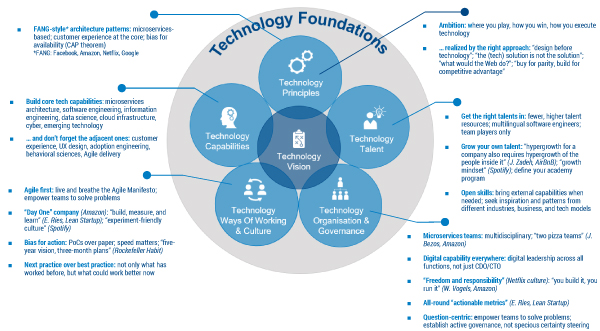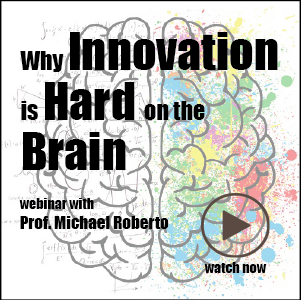CUTTER BUSINESS TECHNOLOGY JOURNAL VOL. 31, NO. 1

This article details four outcome-affecting trends for 2018 (i.e., “trends that impact the ability of a company to leverage emerging technologies in their business”). The authors illustrate how companies can turn these potential trend risks into positive business outcomes through “startup ways of working” and new opportunities in the coming year. In particular, they encourage a return to the principles of the Agile Manifesto and a hard look at the technology foundations.
While KPCB venture partner Mary Meeker’s annual “Internet Trends” report does an outstanding job as a “State of the Digital Nation,” there is no single user manual on the related trends affecting how companies can leverage emerging technology. Often there is asymmetry between the apparent positive trends from emerging technology and the negative trends these can create for established companies.
We therefore select four “outcome-affecting trends” to highlight for 2018 (i.e., trends that impact the ability of a company to leverage emerging technology in their business) from our work with established companies in 2017. Despite crossing multiple sectors, these companies all share the characteristic of the need to leverage emerging technology and startup ways of working to address the major initiatives in question. We hope these trends may be of use in leveraging new technologies as you solve your own business problems and address new opportunities in 2018.
1. The Mask of POSIWID
Elvis once sang, “A little less conversation, a little more action, please.” Similarly, throughout 2017, we encountered a rise in saying rather than doing innovation.
Stafford Beer coined the term POSIWID, and we would propose this term as a front-of-mind trend for 2018. “The purpose of a system is what it does” — referring to “system” as the company as a whole — means that a company’s statements of intent (“we are an innovative, digital native company”), or even its market analysis or the initiatives it has undertaken, are secondary to what a company actually does. When you lift the hood, you may find the engine is not designed to adapt.
This has significant consequences when we consider the parts of a company that come together into an activity system to solve a business problem or address a new opportunity leveraging emerging technologies. What objectives do these parts actually have (not what is stated in the project governance model)?
Is there an aligned goal, or are motivations from the current system, by definition, part of the problem and misaligned? Is the team following best practice (what worked before/what I already know) or next practice (what could work better now/what should I know)? Are the technologies aiding question-centric “bubbles of innovation” (e.g., rapid design to value, loosely coupled, and microservices capable)? Most important, is the team doing something that is moving the dial or changing the game for customers?
To paraphrase The Lean Startup author Eric Ries, your customers “don’t care if you live or die,” they just want the best product or service. POSIWID reinforces this idea by pointing out that your customers don’t care if you say you are providing better products or services; they only care about the best products or services.
2. The Technology “Feel Good” Factor
The rise of hypercompetition and the associated rise of emerging technologies has created a trap for many companies, and it is a trend to be mindful of. Embracing new technology en masse in the stated intent to increase competitiveness or innovate with new business models can make things worse, not better.
Current business and operating models can be made even more rigid with a whole set of new technology thrown at them, while creating a false “feel good” factor that the technology itself will improve competitiveness or lead to innovation.
In the rapidly expanding landscape of new technology available to all companies, if ever there was a year to start asking the right questions and providing the safe bubble of innovation that teams need to address these questions (question-centric, not technology-centric) — and have a bias for delivering innovation rather than talking about it — 2018 is it.
3. Partial Adoption of the Agile Manifesto = A Risky Shift
Related to POSIWID, another outcome-affecting trend we see for 2018 is the need for the return to the Agile Manifesto. We found in our work in 2017 that, while many companies believe they are doing Agile, their ways of thinking, working, and providing executive oversight do not pass the 12-part litmus test (see sidebar “Let’s Review the 12 Principles of the Agile Manifesto”). In particular, we found a risk of recurring reversion in established companies doing the following:
-
Using expensive design studios in San Francisco, New York, or London, for example, plus lower-cost remote software engineering
-
Having the most senior person in the room determine the solution before the team even starts
-
Favoring specious certainty over real-world delivery (e.g., attempting to analyze everything up front, creating a two-year plan for a solution, and then requiring the project to deliver to this schedule without taking real-world feedback into account)
Let’s Review the 12 Principles of the Agile Manifesto
-
Ensure customer satisfaction by early and continuous delivery of valuable software.
-
Welcome changing requirements, even in late development.
-
Deliver working software frequently (in weeks rather than months).
-
Enable close, daily cooperation between business people and developers.
-
Build projects around motivated individuals, who should be trusted.
-
Face-to-face conversation is the best form of communication (i.e., collocation).
-
Working software is the primary measure of progress.
-
Aim for sustainable development — the ability to maintain a constant pace.
-
Pay continuous attention to technical excellence and good design.
-
Simplicity (the art of maximizing the amount of work not done) is essential.
-
The best architectures, requirements, and designs emerge from self-organizing teams.
-
The team should regularly reflect on how to become more effective and adjust accordingly.
These reversions breach half of the principles behind the Agile Manifesto. The first breaches principles four and six; the second contravenes principle five; and the third violates one, three, and seven. Breaching of these principles normally comes with well-argued justifications, but ultimately our experience finds that these are specious arguments born out of motivations other than solving the problem at hand, and they make innovation harder to deliver, not easier. Therefore, we suggest a return to the Agile Manifesto and its principles as a project checklist.
4. Lacking Technology Foundations
In 2018, businesses will likely find out if they are not equipped with the right technology foundations — those essential capabilities both in terms of technology and ways of working (see Figure 1).

According to The Economist, even tech giants like IBM can be surprisingly at risk of lagging in emerging technology such as cloud computing and artificial intelligence: “Technology giants are a bit like dinosaurs. Most do not adapt successfully to a new age — a ‘platform shift’ in the lingo.”
Ways of working are also a vital capability; specifically, a company’s ability to solve the right problem in the right way, even for apparently well-trodden paths — not to mention in pursuit of innovation! While the FoxMeyer Drugs ERP failure (a large US $100 million, multiyear project set to implement a technology unfit for purpose) received a lot of attention back in the 1990s, about 60% of ERP projects still fail, according to ERP Focus.
We predict 2018 to be a year when companies’ technology foundations will be particularly tested. In a world being “eaten by software,” where everything is being digitalized and becoming software definable, businesses are challenged to keep pace.
Responding to the Trend Risks
In 2018, we believe businesses will be exposed to the growing challenge of “specious technology” and “specious projects,” as summarized by the four trends described in this article.
By “specious technology,” we mean technology that is superficially plausible; even misleadingly attractive. And by “specious projects,” we mean projects solving the wrong problems or taking the wrong approach to the right problems; either way, with well-crafted arguments that appear attractive. This also includes initiatives that claim innovation and increase the false comfort blanket of innovation, but don’t do innovation (POSIWID). The combination of specious technology and specious projects is deadly.
 To summarize the findings from our work with companies that have turned each of these potential trend risks into something positive, we suggest the following path for 2018:
To summarize the findings from our work with companies that have turned each of these potential trend risks into something positive, we suggest the following path for 2018:
-
Recognize POSIWID. Talking more about innovation than doing does not meet customer needs. Management action: Bias your teams for innovation action (doing work, not making work). Establish as a minimum the quarterly value review of actual delivery plus real customer feedback.
-
Avoid the technology trap. Throwing technology at the wrong problems will not increase competitiveness. Management action: Have clear sight on what problems are being solved for whom and ensure no conflation of “what” with “how.” Ensure technology is being used to enhance adaptability, not increase rigidity.
-
Follow the Agile Manifesto. We see a tendency to breach the Agile Manifesto. Management action: Ensure the most important initiatives follow all 12 Agile Manifesto principles. Beware of well-constructed arguments for bypassing one or more of these principles. There’s a reason the Agile Manifesto works.
-
Focus on technology foundations. Companies will no longer get away with poor technology foundations. Specious technology will find specious projects. Management action: Take an objective SWOT of your current foundations (see sidebar “More About Foundations”) and ask, “Would a FANG (Facebook, Amazon, Netflix, Google) company do this?” We like to use the meme “WWWD” (What Would the Web Do?) as a guiding principle, not only for specific projects but also to inform sustainable technology capability development.
More About Foundations
We find that successful companies share a trait of having a conscious strategy to deploy FANG-like technology foundations, covering both technology fundamentals (high expertise in software engineering, data science, platform engineering, etc.) and ways of working that are Lean startup by default.
Based on work in 2017 in bridging the “startup to established company” gap, we find that a minimal capability foundation is required for companies to sort out the tech hype from the real tech, and equally as important, to build capabilities that can address real business problems for the customer, rather than deliver solutions that ultimately maintain the internal status quo. Each capability lives and breathes the culture and ways of working as exemplified by FANG companies.1
1For more on these practices, see “Becoming a Next Practice Business” and “Moving from ‘Best Practice to Next Practice’ to Drive Effective Digital Transformation.”
When asked how many companies he thought would actually take on real innovation and work in the startup way, Ries replied, “The vast majority will not implement it at all.” In 2018, will yours be one of them?




